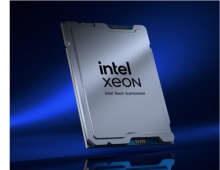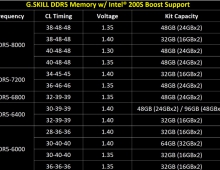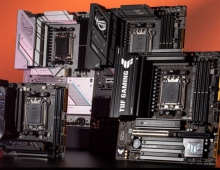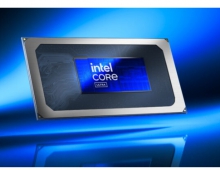
Intel develops first continuous laser from standard silicon
Major advance could lead to new innovations in computing, communications and medical applications
Intel announced a scientific breakthrough using standard silicon manufacturing processes to create the world's first continuous wave silicon laser. This technology could help bring low-cost, high-quality lasers and optical devices to mainstream use in computing, communications and medical applications.
As reported in today's issue of the journal Nature, Intel researchers have found a way to use the so-called Raman effect and silicon's crystalline structure to amplify light as it passes through it. When infused with light from an external source the experimental chip produces a continuous, high-quality laser beam. While still far from becoming a commercial product, the ability to build a laser from standard silicon could lead to inexpensive optical devices that move data inside and between computers at the speed of light - ushering in a flood of new applications for high-speed computing.
"Fundamentally, we have demonstrated for the first time that standard silicon can be used to build devices that amplify light," said Dr. Mario Paniccia, director, Intel's Photonics Technology Lab. "The use of high-quality photonic devices has been limited because they are expensive to manufacture, assemble and package. This research is a major step toward bringing the benefits of low-cost, high-bandwidth silicon based optical devices to the mass market."
Today, every computer has a power supply to drive the chips, hard disc and peripherals. In the future, PCs may also come with a supply for powering tiny lasers, amplifiers and optical interconnects that move terabytes of data around the computer and across networks. In addition, there are special wavelengths of light that are optimal for interactions with human tissue. For example, one type of laser wavelength is useful for working on gums and another one for excavating cavities in teeth. Today, these lasers cost tens of thousands of dollars each, limiting their use. Potential future uses of Intel's breakthrough technology could lead to more affordable medical lasers so that trips to the dentist become easier and less painful for patients.
Technical Details
Building a Raman laser in silicon begins with etching a waveguide -- a conduit for light on a chip. Silicon is transparent to infrared light so that when light is directed into a waveguide it can be contained and channeled across a chip. Like the first laser developed in 1960, Intel researchers used an external light source to "pump" light into their chip. As light is pumped in, the natural atomic vibrations in silicon amplify the light as it passes through the chip. This amplification - the Raman effect -- is more than 10,000 times stronger in silicon than in glass fibers. Raman lasers and amplifiers are used today in the telecom industry and rely on miles of fiber to amplify light. By using silicon, Intel researchers were able to achieve gain and lasing in a silicon chip just a few centimeters in size.
A laser is widely considered to be any device that emits an intense, coherent beam of light (where the photons all have the same wavelength, phase, and direction). By coating the sides of the chip with a reflective thin-film material, similar to coatings used on high-quality sunglasses, the team was able to contain and amplify the light as it bounced back in forth inside the chip. As they increased the pump energy a critical threshold point was reached where instantaneously, a very precise beam of coherent light (i.e., laser) exited the chip.
The Breakthrough
Initially, they discovered increasing the light pump power beyond a certain point no longer increased amplification and eventually even decreased it. The reason was a physical process called "Two-Photon Absorption," which occurs when two photons from the pump beam hit an atom at the same time and knock an electron away. These excess electrons build up over time and collect in the waveguide until they absorb so much light that amplification stops.
Intel's breakthrough solution was to integrate a semiconductor structure, technically called a PIN (P-type - Intrinsic - N-type) device into the waveguide. When a voltage is applied to the PIN, it acts like a vacuum and removes most of the excess electrons from the light's path. The PIN device combined with the Raman effect produces a continuous laser beam.
Making Silicon & Light Work Together
Silicon Photonics research at Intel began as a way to explore applying the company's silicon expertise to the development of integrated optical devices that could be incorporated into a variety of products by Intel's customers. The silicon photonics research team has achieved a number of breakthroughs, starting in 2004 with the first silicon-based optical modulator to encode data at 1GHz, an increase of over 50 times the previous research record of about 20MHz.
The report on this research was published in Nature, Volume 433, dated February 17, 2005. The paper, titled "A continuous wave Raman Silicon Laser," was authored by Intel researchers Haisheng Rong, Richard Jones, Ansheng Liu, Oded Cohen, Dani Hak, Alexander Fang & Mario Paniccia. A copy of the paper and more information can be found at http://www.intel.com/go/sp/.
As reported in today's issue of the journal Nature, Intel researchers have found a way to use the so-called Raman effect and silicon's crystalline structure to amplify light as it passes through it. When infused with light from an external source the experimental chip produces a continuous, high-quality laser beam. While still far from becoming a commercial product, the ability to build a laser from standard silicon could lead to inexpensive optical devices that move data inside and between computers at the speed of light - ushering in a flood of new applications for high-speed computing.
"Fundamentally, we have demonstrated for the first time that standard silicon can be used to build devices that amplify light," said Dr. Mario Paniccia, director, Intel's Photonics Technology Lab. "The use of high-quality photonic devices has been limited because they are expensive to manufacture, assemble and package. This research is a major step toward bringing the benefits of low-cost, high-bandwidth silicon based optical devices to the mass market."
Today, every computer has a power supply to drive the chips, hard disc and peripherals. In the future, PCs may also come with a supply for powering tiny lasers, amplifiers and optical interconnects that move terabytes of data around the computer and across networks. In addition, there are special wavelengths of light that are optimal for interactions with human tissue. For example, one type of laser wavelength is useful for working on gums and another one for excavating cavities in teeth. Today, these lasers cost tens of thousands of dollars each, limiting their use. Potential future uses of Intel's breakthrough technology could lead to more affordable medical lasers so that trips to the dentist become easier and less painful for patients.
Technical Details
Building a Raman laser in silicon begins with etching a waveguide -- a conduit for light on a chip. Silicon is transparent to infrared light so that when light is directed into a waveguide it can be contained and channeled across a chip. Like the first laser developed in 1960, Intel researchers used an external light source to "pump" light into their chip. As light is pumped in, the natural atomic vibrations in silicon amplify the light as it passes through the chip. This amplification - the Raman effect -- is more than 10,000 times stronger in silicon than in glass fibers. Raman lasers and amplifiers are used today in the telecom industry and rely on miles of fiber to amplify light. By using silicon, Intel researchers were able to achieve gain and lasing in a silicon chip just a few centimeters in size.
A laser is widely considered to be any device that emits an intense, coherent beam of light (where the photons all have the same wavelength, phase, and direction). By coating the sides of the chip with a reflective thin-film material, similar to coatings used on high-quality sunglasses, the team was able to contain and amplify the light as it bounced back in forth inside the chip. As they increased the pump energy a critical threshold point was reached where instantaneously, a very precise beam of coherent light (i.e., laser) exited the chip.
The Breakthrough
Initially, they discovered increasing the light pump power beyond a certain point no longer increased amplification and eventually even decreased it. The reason was a physical process called "Two-Photon Absorption," which occurs when two photons from the pump beam hit an atom at the same time and knock an electron away. These excess electrons build up over time and collect in the waveguide until they absorb so much light that amplification stops.
Intel's breakthrough solution was to integrate a semiconductor structure, technically called a PIN (P-type - Intrinsic - N-type) device into the waveguide. When a voltage is applied to the PIN, it acts like a vacuum and removes most of the excess electrons from the light's path. The PIN device combined with the Raman effect produces a continuous laser beam.
Making Silicon & Light Work Together
Silicon Photonics research at Intel began as a way to explore applying the company's silicon expertise to the development of integrated optical devices that could be incorporated into a variety of products by Intel's customers. The silicon photonics research team has achieved a number of breakthroughs, starting in 2004 with the first silicon-based optical modulator to encode data at 1GHz, an increase of over 50 times the previous research record of about 20MHz.
The report on this research was published in Nature, Volume 433, dated February 17, 2005. The paper, titled "A continuous wave Raman Silicon Laser," was authored by Intel researchers Haisheng Rong, Richard Jones, Ansheng Liu, Oded Cohen, Dani Hak, Alexander Fang & Mario Paniccia. A copy of the paper and more information can be found at http://www.intel.com/go/sp/.





















